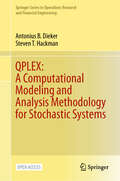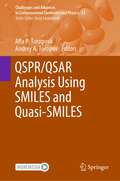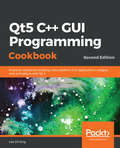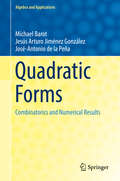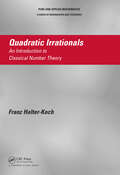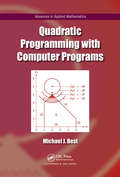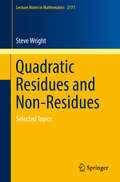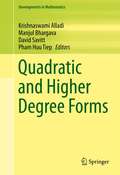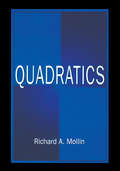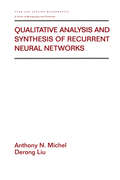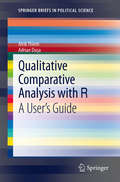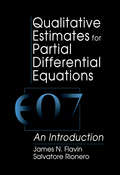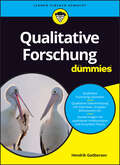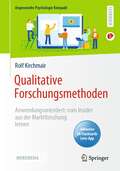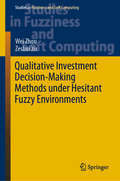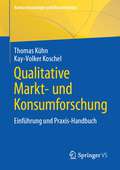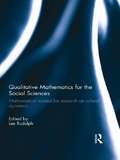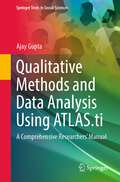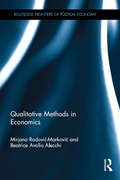- Table View
- List View
QPLEX: A Computational Modeling and Analysis Methodology for Stochastic Systems (Springer Series in Operations Research and Financial Engineering)
by Steven T. Hackman Antonius B. DiekerThis book introduces QPLEX, a powerful computational framework designed for modeling and analyzing nonstationary stochastic systems with large state spaces. The methodology excels at rapidly and accurately generating approximate distributions of system performance over time, offering a robust tool for understanding the dynamics of such systems. QPLEX circumvents the curse of dimensionality by imposing conditional independence, which may be represented via a probabilistic graphical model, and exploiting model dynamics. It is specifically crafted for transient analysis of nonstationary systems, often encountered in practical applications but rarely addressed by traditional techniques. It can work directly with empirical distributions and requires no stability assumptions. Since its output is not noisy, QPLEX is tailor-made for sensitivity analysis and optimization. The methodology’s few model primitives are flexible enough to specify a rich array of models. For example, models representing queueing networks can exhibit challenging characteristics such as short operational horizons; time-varying arrival rates, service durations, and numbers of servers; and complex routing of entities. The text is accessible to those with engineering, computer science, or mathematics backgrounds and knowledge of probability and stochastic models at the advanced undergraduate level. Many fully worked-out examples aid the comprehension of the concepts and calculations, ensuring readers can effectively apply the methods to real-world systems and making this book a valuable resource for researchers and practitioners alike. This is an open access book.
QSPR/QSAR Analysis Using SMILES and Quasi-SMILES (Challenges and Advances in Computational Chemistry and Physics #33)
by Alla P. Toropova Andrey A. ToropovThis contributed volume overviews recently presented approaches for carrying out QSPR/QSAR analysis by using a simplifying molecular input-line entry system (SMILES) to represent the molecular structure. In contrast to traditional SMILES, quasi-SMILES is a sequence of special symbols-codes that reflect molecular features and codes of experimental conditions. SMILES and quasi-SMILES serve as a basis to develop QSPR/QSAR as well Nano-QSPR/QSAR via the Monte Carlo calculation that provides the so-called optimal descriptors for QSPR/QSAR models. The book presents a reliable technology for developing Nano-QSPR/QSAR while it also includes the description of the algorithms of the Monte Carlo optimization. It discusses the theory and practice of the technique of variational authodecoders (VAEs) based on SMILES and analyses in detail the index of ideality of correlation (IIC) and the correlation intensity index (CII) which are new criteria for the predictive potential of the model. The mathematical apparatus used is simple so that students of relevant specializations can easily follow. This volume is a valuable contribution to the field and will be of great interest to developers of models of physicochemical properties and biological activity, chemical technologists, and toxicologists involved in the area of drug design.
Qiskit Pocket Guide: Quantum Development with Qiskit
by James L. Weaver Frank J. HarkinsThe quantum computing market is predicted to grow by nearly $1.3 billion over the next five years. Why? Given their quantum mechanical nature, quantum computers are expected to solve difficult problems in chemistry, optimization, finance, and machine learning that classical computers find impossible to unravel.This pocket guide provides software developers with a quick reference to Qiskit, an open source SDK for working with quantum computers. Packed with helpful programming examples, tables, figures, and lists, this handy book helps you find the information you need to develop and debug quantum programs.Whether you're focused on business, engineering, or scientific applications, you'll learn how to choose and apply appropriate Qiskit classes, methods, and functions.Learn how to create quantum circuits, define quantum gates, and leverage the transpilerExplore modules for implementing quantum information concepts and quantum algorithmsSurvey features of Qiskit that abstract and facilitate working with various quantum computers and simulatorsLearn how to use the latest version of the Open Quantum Assembly Language
Qt5 C++ GUI Programming Cookbook: Practical recipes for building cross-platform GUI applications, widgets, and animations with Qt 5
by Lee Zhi Eng<p>Use Qt 5 to design and build functional, appealing, and user-friendly graphical user interfaces (GUIs) for your applications. <p>Key Features: <p> <li>Learn to use Qt 5 to design and customize the look and feel of your application <li>Improve the visual quality of an application by using graphics rendering and animation <li>Understand the balance of presentation and web content that will make an application appealing yet functional</li> <p> <p>Book Description: <p>With the growing need to develop GUIs for multiple targets and multiple screens, improving the visual quality of your application becomes important so that it stands out from your competitors. With its cross-platform ability and the latest UI paradigms, Qt makes it possible to build intuitive, interactive, and user-friendly user interfaces for your applications. <p>Qt5 C++ GUI Programming Cookbook, Second Edition teaches you how to develop functional and appealing user interfaces using the latest version of QT5 and C++.This book will help you learn a variety of topics such as GUI customization and animation, graphics rendering, implementing Google Maps, and more. You will also be taken through advanced concepts like asynchronous programming, event handling using signals and slots, network programming, various aspects of optimizing your application. <p>By the end of the book, you will be confident to design and customize GUI applications that meet your clients' expectations and have an understanding of best practice solutions for common problems. <p>What you will learn: <p> <li>Animate GUI elements using Qt5's built-in animation system <li>Draw shapes and 2D images using Qt5's powerful rendering system <li>Implement an industry-standard OpenGL library in your project <li>Build a mobile app that supports touch events and exports it onto devices <li>Parse and extract data from an XML file and present it on your GUI <li>Interact with web content by calling JavaScript functions from C++ <li>Access MySQL and SQLite databases to retrieve data and display it on your GUI</li> <p> <p>Who this book is for: This intermediate-level book is designed for those who want to develop software using Qt 5. If you want to improve the visual quality and content presentation of your software application, this book is for you. Prior experience of C++ programming is required.</p>
Quadrangular Algebras. (Mathematical Notes #46)
by Richard M. WeissThis book introduces a new class of non-associative algebras related to certain exceptional algebraic groups and their associated buildings. Richard Weiss develops a theory of these "quadrangular algebras" that opens the first purely algebraic approach to the exceptional Moufang quadrangles. These quadrangles include both those that arise as the spherical buildings associated to groups of type E6, E7, and E8 as well as the exotic quadrangles "of type F4" discovered earlier by Weiss. Based on their relationship to exceptional algebraic groups, quadrangular algebras belong in a series together with alternative and Jordan division algebras. Formally, the notion of a quadrangular algebra is derived from the notion of a pseudo-quadratic space (introduced by Jacques Tits in the study of classical groups) over a quaternion division ring. This book contains the complete classification of quadrangular algebras starting from first principles. It also shows how this classification can be made to yield the classification of exceptional Moufang quadrangles as a consequence. The book closes with a chapter on isotopes and the structure group of a quadrangular algebra. Quadrangular Algebras is intended for graduate students of mathematics as well as specialists in buildings, exceptional algebraic groups, and related algebraic structures including Jordan algebras and the algebraic theory of quadratic forms.
Quadratic Diophantine Equations
by Titu Andreescu Dorin AndricaThis text treats the classical theory of quadratic diophantine equations and guides the reader through the last two decades of computational techniques and progress in the area. The presentation features two basic methods to investigate and motivate the study of quadratic diophantine equations: the theories of continued fractions and quadratic fields. It also discusses Pell's equation and its generalizations, and presents some important quadratic diophantine equations and applications. The inclusion of examples makes this book useful for both research and classroom settings.
Quadratic Forms: Combinatorics And Numerical Results (Algebra and Applications #25)
by Michael Barot Jesús Arturo Jiménez González José-Antonio de la PeñaThis monograph presents combinatorial and numerical issues on integral quadratic forms as originally obtained in the context of representation theory of algebras and derived categories. Some of these beautiful results remain practically unknown to students and scholars, and are scattered in papers written between 1970 and the present day. Besides the many classical results, the book also encompasses a few new results and generalizations. The material presented will appeal to a wide group of researchers (in representation theory of algebras, Lie theory, number theory and graph theory) and, due to its accessible nature and the many exercises provided, also to undergraduate and graduate students with a solid foundation in linear algebra and some familiarity on graph theory.
Quadratic Irrationals: An Introduction to Classical Number Theory (Chapman & Hall/CRC Pure and Applied Mathematics)
by Franz Halter-KochQuadratic Irrationals: An Introduction to Classical Number Theory gives a unified treatment of the classical theory of quadratic irrationals. Presenting the material in a modern and elementary algebraic setting, the author focuses on equivalence, continued fractions, quadratic characters, quadratic orders, binary quadratic forms, and class groups.T
Quadratic Programming with Computer Programs (Advances in Applied Mathematics)
by Michael J. BestQuadratic programming is a mathematical technique that allows for the optimization of a quadratic function in several variables. QP is a subset of Operations Research and is the next higher lever of sophistication than Linear Programming. It is a key mathematical tool in Portfolio Optimization and structural plasticity. This is useful in Civil Engineering as well as Statistics.
Quadratic Residues and Non-Residues
by Steve WrightThis book offers an account of the classical theory of quadratic residues and non-residues with the goal of using that theory as a lens through which to view the development of some of the fundamental methods employed in modern elementary, algebraic, and analytic number theory. The first three chapters present some basic facts and the history of quadratic residues and non-residues and discuss various proofs of the Law of Quadratic Reciprosity in depth, with an emphasis on the six proofs that Gauss published. The remaining seven chapters explore some interesting applications of the Law of Quadratic Reciprocity, prove some results concerning the distribution and arithmetic structure of quadratic residues and non-residues, provide a detailed proof of Dirichlet's Class-Number Formula, and discuss the question of whether quadratic residues are randomly distributed. The text is a valuable resource for graduate and advanced undergraduate students as well as for mathematicians interested in number theory.
Quadratic and Higher Degree Forms
by Krishnaswami Alladi Manjul Bhargava Pham Huu Tiep David SavittIn the last decade, the areas of quadratic and higher degree forms have witnessed dramatic advances. This volume is an outgrowth of three seminal conferences on these topics held in 2009, two at the University of Florida and one at the Arizona Winter School. The volume also includes papers from the two focused weeks on quadratic forms and integral lattices at the University of Florida in 2010.Topics discussed include the links between quadratic forms and automorphic forms, representation of integers and forms by quadratic forms, connections between quadratic forms and lattices, and algorithms for quaternion algebras and quadratic forms. The book will be of interest to graduate students and mathematicians wishing to study quadratic and higher degree forms, as well as to established researchers in these areas. Quadratic and Higher Degree Forms contains research and semi-expository papers that stem from the presentations at conferences at the University of Florida as well as survey lectures on quadratic forms based on the instructional workshop for graduate students held at the Arizona Winter School. The survey papers in the volume provide an excellent introduction to various aspects of the theory of quadratic forms starting from the basic concepts and provide a glimpse of some of the exciting questions currently being investigated. The research and expository papers present the latest advances on quadratic and higher degree forms and their connections with various branches of mathematics.
Quadratics (Discrete Mathematics and Its Applications #2)
by Richard A. MollinThe first thing you will find out about this book is that it is fun to read. It is meant for the browser, as well as for the student and for the specialist wanting to know about the area. The footnotes give an historical background to the text, in addition to providing deeper applications of the concept that is being cited. This allows the browser to look more deeply into the history or to pursue a given sideline. Those who are only marginally interested in the area will be able to read the text, pick up information easily, and be entertained at the same time by the historical and philosophical digressions. It is rich in structure and motivation in its concentration upon quadratic orders.This is not a book that is primarily about tables, although there are 80 pages of appendices that contain extensive tabular material (class numbers of real and complex quadratic fields up to 104; class group structures; fundamental units of real quadratic fields; and more!). This book is primarily a reference book and graduate student text with more than 200 exercises and a great deal of hints! The motivation for the text is best given by a quote from the Preface of Quadratics: "There can be no stronger motivation in mathematical inquiry than the search for truth and beauty. It is this author's long-standing conviction that number theory has the best of both of these worlds. In particular, algebraic and computational number theory have reached a stage where the current state of affairs richly deserves a proper elucidation. It is this author's goal to attempt to shine the best possible light on the subject."
Quadratische Zahlkörper
by Franz LemmermeyerDie Theorie der quadratischen Zahlkörper ist der erste Schritt hin auf eine allgemeine Theorie algebraischer Zahlkörper. In diesem Buch werden die Hauptsätze der Theorie nicht auf dem kürzesten Weg bewiesen; vielmehr nehmen wir uns die Zeit, uns auf kleinen Umwegen mit den neuen Objekten vertraut zu machen und die Sätze an vielen Beispielen zu illustrieren. Außerdem gehen wir ausführlich auf die Geschichte der algebraischen Zahlentheorie ein und besprechen einige für die Entwicklung dieser Disziplin wichtige Beispiele. Dabei spielen vor allem diophantische Gleichungen eine große Rolle. Abgerundet wird das Buch durch zahlreiche Übungsaufgaben und eine kurze Einführung in das Rechnen mit Pari und Sage.
Qualitative Analysis and Synthesis of Recurrent Neural Networks (Chapman & Hall/CRC Pure and Applied Mathematics)
by Anthony Michel Derong Liu"Analyzes the behavior, design, and implementation of artificial recurrent neural networks. Offers methods of synthesis for associative memories. Evaluates the qualitative properties and limitations of neural networks. Contains practical applications for optimal system performance."
Qualitative Analysis: Practice And Innovation
by Douglas EzzyOffering a detailed introduction to the practice of data analysis, this book is both user-friendly and theoretically grounded. Drawing on his extensive experience of qualitative research, Douglas Ezzy reviews approaches to data analysis in established research traditions including ethnography, phenomenology and symbolic interactionism, alongside the newer approaches informed by cultural studies and feminism. He explains the difference between inductive, deductive and abductive theory building, provides a guide to computer-assisted analysis and outlines techniques such as journal writing, team meetings and participant reviews.This text is one of the first to treat computer assisted data analysis as an integral part of qualitative research. Exceptionally well written, this is a valuable reference for research students and professional researchers in the social sciences and health.
Qualitative Comparative Analysis with R
by Adrian Dusa Alrik ThiemSocial science theory often builds on sets and their relations. Correlation-based methods of scientific enquiry, however, use linear algebra and are unsuited to analyzing set relations. The development of Qualitative Comparative Analysis (QCA) by Charles Ragin has given social scientists a formal tool for identifying set-theoretic connections based on Boolean algebra. As a result, interest in this method has markedly risen among social scientists in recent years. This book offers the first complete introduction on how to perform QCA in the R software environment for statistical computing and graphics with the QCA package. Developed as a comprehensive solution, QCA provides an unprecedented scope of functionality for analyzing crisp, multi-value and fuzzy sets. The reader is not required to have knowledge of R, but the book assumes an understanding of the fundamentals of QCA. Using examples from published work, the authors demonstrate how to make the most of QCA's wide-ranging capabilities for the reader's own purposes. Although mainly written for political scientists, this book is also of interest to scholars from other disciplines in the social sciences such as sociology, business, management, organization, anthropology, education and health.
Qualitative Estimates For Partial Differential Equations: An Introduction
by J N Flavin S. RioneroQualitative Estimates For Partial Differential Equations: An Introduction describes an approach to the use of partial differential equations (PDEs) arising in the modelling of physical phenomena. It treats a wide range of differential inequality techniques applicable to problems arising in engineering and the natural sciences, including fluid and solid mechanics, physics, dynamics, biology, and chemistry. The book begins with an elementary discussion of the fundamental principles of differential inequality techniques for PDEs arising in the solution of physical problems, and then shows how these are used in research.Qualitative Estimates For Partial Differential Equations: An Introduction is an ideal book for students, professors, lecturers, and researchers who need a comprehensive introduction to qualitative methods for PDEs arising in engineering and the natural sciences.
Qualitative Forschung für Dummies (Für Dummies)
by Hendrik GodbersenSo werden aus Worten Daten Sie wollen bei einer Untersuchung mehr über Motive und Anliegen der zu untersuchenden Gruppe wissen? Dann helfen Ihnen die Methoden der qualitativen Forschung weiter. Hendrik Godbersen erklärt Ihnen von der Pike auf, was Sie über qualitative Forschung wissen müssen, um selbst eine Untersuchung vorzunehmen. Er erläutert dabei den qualitativen Forschungsansatz, Ziele und Designs sowie die Gütekriterien. Außerdem vermittelt er Ihnen, wie Sie Forschungsarbeiten strukturieren, Daten erheben und auswerten und zuletzt die Ergebnisse interpretieren. So wird Ihre Untersuchung gewiss ein Erfolg. Sie erfahren Wie Sie Interviews führen und Gruppendiskussionen leiten Wie Sie qualitative Daten aufzeichnen und transkribieren Wie Sie die richtige Methode für die Datenauswertung nutzen Wie Sie die Qualität Ihrer Untersuchung sichern
Qualitative Forschungsmethoden: Anwendungsorientiert: vom Insider aus der Marktforschung lernen (Angewandte Psychologie Kompakt)
by Rolf KirchmairEndlich ein Buch über qualitative Forschungsmethoden, das Ihnen im Studium und in der Alltagspraxis einen umfassenden Überblick über qualitative Forschung bietet und qualitative Methoden durch konkrete Formulierungsbeispiele transparent macht.Dieses Lehrbuch beinhaltet alle wichtigen Verfahren wie:Qualitative InterviewsFocus GroupsKreativitätstechniken Methoden der indirekten Befragung und ihre Auswertungneueste Ansätze der qualitativen Onlineforschung, etc.Wissenschaftlich fundiert und dennoch angenehm lesbar hilft es durch den starken Praxisbezug, die Lerninhalte gut im Gedächtnis zu verankern. Durch den klaren didaktischen Aufbau mit Lernzielen, Anwendungsbeispielen, Schlüsselbegriffen, Prüfungsfragen und Zusammenfassungen sowie die eingebundenen Audioclips verhilft es im Studium zu nachhaltigem Lernerfolg. In der Alltagspraxis unterstützt es durch Formulierungsvorschläge den Einsatz qualitativer Methoden. Eine Begleitwebseite bereichert dieses Lehrbuch mit hilfreichen Zusatzmaterialien.Zusätzlich sind Fragen und Antworten zum Selbsttest und zur Prüfungsvorbereitung über die SN Flashcards Lern-App inkludiert. Der Zugangscode befindet sich im gedruckten Buch.Die ZielgruppenStudierende und Lehrende der Psychologie, Wirtschaftspsychologie und angrenzender Disziplinen, die Grundlegendes in kompakter, übersichtlicher und praxisnaher Form verstehen und anwenden wollen. Auch geeignet für Forscher und Professionals im Institut und Unternehmen.Zum AutorRolf Kirchmair ist Diplompsychologe, Institutsmarktforscher und Hochschuldozent mit jahrzehntelanger Praxiserfahrung in der qualitativen Forschung.
Qualitative Investment Decision-Making Methods under Hesitant Fuzzy Environments (Studies in Fuzziness and Soft Computing #376)
by Wei Zhou Zeshui XuThis book describes five qualitative investment decision-making methods based on the hesitant fuzzy information. They are: (1) the investment decision-making method based on the asymmetric hesitant fuzzy sigmoid preference relations, (2) the investment decision-making method based on the hesitant fuzzy trade-off and portfolio selection, (3) the investment decision-making method based on the hesitant fuzzy preference envelopment analysis, (4) the investment decision-making method based on the hesitant fuzzy peer-evaluation and strategy fusion, and (5) the investment decision-making method based on the EHVaR measurement and tail analysis.
Qualitative Markt- und Konsumforschung: Einführung und Praxis-Handbuch (Konsumsoziologie und Massenkultur)
by Thomas Kühn Kay-Volker KoschelDie Autoren Thomas Kühn und Kay-Volker Koschel geben in diesem Buch eine praxisnahe Einführung in Grundgedanken und Methoden der qualitativen Markt- und Konsumforschung. Zur Veranschaulichung werden zahlreiche Praxisbeispiele gegeben und typische Fehler bei der Konzeption typischer Studien identifiziert und Lösungsmöglichkeiten angeboten.
Qualitative Mathematics for the Social Sciences: Mathematical Models for Research on Cultural Dynamics (Cultural Dynamics of Social Representation)
by Lee RudolphIn this book Lee Rudolph brings together international contributors who combine psychological and mathematical perspectives to analyse how qualitative mathematics can be used to create models of social and psychological processes. Bridging the gap between the fields with an imaginative and stimulating collection of contributed chapters, the volume updates the current research on the subject, which until now has been rather limited, focussing largely on the use of statistics. Qualitative Mathematics for the Social Sciences contains a variety of useful illustrative figures, introducing readers from the social sciences to the rich contribution that modern mathematics has made to our knowledge of logic, structures, and dynamic systems. A beguiling array of conceptual systems, topological models and fractals are discussed which transcend the application of statistics, and bring a fresh perspective to the study of social representations. The wide selection of qualitative mathematical methodologies discussed in this volume will be hugely valuable to higher-level undergraduate and postgraduate students of psychology, sociology and mathematics. It will also be useful for researchers, academics and professionals from the social sciences who want a firmer grasp on the use of qualitative mathematics.
Qualitative Methods and Data Analysis Using ATLAS.ti: A Comprehensive Researchers’ Manual (Springer Texts in Social Sciences)
by Ajay GuptaThis book provides an in-depth roadmap for qualitative research methods and data analysis across disciplines using ATLAS.ti. It encompasses and rationalizes key qualitative research concepts and methods with innovative frameworks to enrich the reader’s understanding of qualitative research methods and data analysis. The book contains multiple real-world projects that assist readers in developing conceptual and theoretical knowledge, as well as gaining insights from fieldwork, visualizing data collection, analysis, and methodological interpretations.This easy to use book provides a pragmatic approach to qualitative methods, proficiency in capturing field observations, user-friendly steps to data analysis starting from transcription, preparation of data, reading and identification of quotations, coding, memoing, commenting, code groups, creating smart codes and groups using set, semantic, and proximity operators resulting in generating numerous insightful thematic reports in a variety of formats.More notable features:- Demonstrates systematic roots to research from begin to end- Provides practical advice on how to overcome field challenges during data collection, ethical considerations, and step-by-step procedures for gaining access to participants and capturing holistic data- Includes numerous numerical arguments, interpretations, and explanations for concepts, themes, variables, networks, and emerging concepts- Includes several research frameworks and data analysis guideposts on real-world research projects with thorough procedures covering 267 images and 38 tables- Compelling for quantitative research and mixed methods approachesThe book's straightforward and user-friendly format makes it simple and easy to use, comprehend, and interpret for anyone working with ATLAS.ti.
Qualitative Methods in Economics (Routledge Frontiers of Political Economy)
by Mirjana Radović-Marković Beatrice Avolio AlecchiDespite numerous books on research methodology, many have failed to present a complete, hands-on, practical book to lead college classes or individuals through the research process. We are seeing more and more scientific papers from all research fields that fail to meet the basic criteria in terms of research methods, as well as the structure, writing style and presentation of results. This book aims to address this gap in the market by providing an authoritative, easy to follow guide to research methods and how to apply them. Qualitative Methods in Economics is focused not only on the research methods/techniques but also the methodology. The main objective of this book is to discuss qualitative methods and their use in economics and social science research. Chapters identify several of the research approaches commonly used in social studies, from the importance of the role of science through to the techniques of data collection. Using an example research paper to examine the methods used to present the research, the second half of this book breaks down how to present and format your results successfully. This book will be of use to students and researchers who want to improve their research methods and read up on the new and cutting edge advances in research methods, as well as those who like to study ways to improve the research process.
